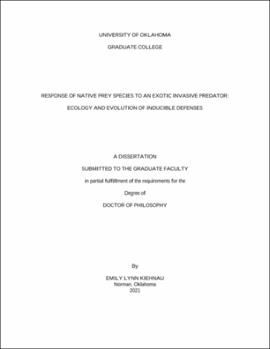| dc.description.abstract | One of the most common and devastating human impacts on the world’s ecosystems is the introduction of non-native invasive species which can negatively impact agriculture, industry, human health, and the natural environment. The invasion of a non-native predator can have particularly damaging effects on native prey species. These impacts are generally attributed to a failure by the prey to recognize a novel enemy and respond appropriately due to lack of experience. However, the response of native prey species to non-native predators is not well understood. Knowledge of this relationship is important for informing policy on non-native species control and management strategies.
In my dissertation, I evaluated the response of three native North American zooplankton prey species (Daphnia pulicaria, Daphnia mendotae, and Daphnia ambigua) to a non-native zooplankton predator (the spiny water flea a.k.a. Bythotrephes) in Lake Mendota (WI). Daphnia, small invertebrate animals, are key members of lake ecosystems because they are primary algae grazers and serve as a major food source for commercially and recreationally important fish species. Daphnia are the preferred prey of Bythotrephes, a non-native invertebrate predator from Northern Eurasia. Predation of Bythotrephes on Daphnia species has the potential to disrupt the functioning of many lakes because when Daphnia are removed, there is less food for fish and less of a constraint on algae growth. For example, since the invasion of Lake Mendota, predation of Bythotrephes on Daphnia has led to a decrease in water clarity of nearly 1 meter, which represents an economic loss (i.e., water quality, recreational use) valued at $140 million per year. The goal of my dissertation is to better understand how native Daphnia species are responding to the invasion of spiny water fleas so that the impacts of current and future invasions can be better predicted, helping us to protect the health and stability of these ecosystems.
To explore how Daphnia are responding to this invasive predator, I isolated and hatched dormant (“resting”) Daphnia eggs (termed ephippia) that have been preserved in lake sediments. This innovative technique has allowed me to “time-travel” and compare the responses of Daphnia from before and after the spiny water flea invasion. I used this method to evaluate a variety of anti-predator defenses (Chapters 1-3) and then assessed how the development of these defenses impacted the population dynamics of Daphnia species at different levels of food availability (Chapter 4). I evaluated both pre-encounter defenses such as depth selection (phototactic) behavior (Chapter 1) and escape ability (Chapter 2), and post-encounter defenses such as changes in morphology (Chapter 3). My research aimed to fill knowledge gaps within the field of invasion biology by tracking the response of native prey species to a non-native predator through time.
The goal of my first chapter was to see if Daphnia from Lake Mendota alter their depth selection behavior when in the presence of Bythotrephes chemical cues. It has been noted that the vertical distribution of Daphnia in invaded lakes is changing. Specifically, high densities of Bythotrephes are correlated with deeper vertical distributions of Daphnia. Bythotrephes are visual predators that require light to forage, thus, Daphnia may be selecting deeper depths when Bythotrephes are present to avoid predation. I performed experiments assessing predator cue-induced depth selection behavior of Daphnia from both pre- and post- invasion time periods. Results from these experiments suggested that Daphnia in Lake Mendota were not altering their depth selection behavior as a strategy to avoid predation by Bythotrephes. This lack of a response appears to indicate a naïve prey behavior, which could explain the reduced Daphnia populations and corresponding decline in water clarity (due to increased algae growth) that has been documented in recent years.
For my second chapter, I conducted a series of laboratory experiments to assess the escape ability of pre- and post- invasion Daphnia in the presence and absence of Bythotrephes and fish chemical cues. It has been observed that those species, whose populations have been heavily impacted by the Bythotrephes invasion have slower swimming speeds, while those that have remained relatively unchanged have faster swimming speeds. Escape ability differed across Daphnia species and post-invasion D. pulicaria had overall enhanced escape ability in comparison to pre-invasion D. pulicaria, which may help them avoid attack by Bythotrephes. Differences in the escape ability of Lake Mendota Daphnia may have contributed to differences in vulnerability, which in turn, may have influenced the community changes observed after the establishment of Bythotrephes
The third chapter of my dissertation compared the morphology of Daphnia from pre- and post-invasion time periods in the presence and absence of Bythotrephes chemical cues. Chemical cues from predators can induce morphological changes in Daphnia, from the development of elongated heads and tail spines to enhanced or reduced eye diameter. These induced morphological changes are defensive agents, which make capture or ingestion by predators more difficult. By measuring previously unassessed traits, I found that native Daphnia are responding to Bythotrephes with species-specific morphological changes. Native Daphnia populations have tracked the introduction of the non-native predator Bythotrephes via a combination of inducible and constitutive morphological defenses.
For my final chapter (Chapter 4), I investigated how the population dynamics of two Daphnia species (D. ambigua and D. pulicaria) native to Lake Mendota are affected by the varying food availability (high versus low food availability) and the presence and absence of Bythotrephes chemical cues. Some Daphnia species develop antipredator defenses such as changes in behavior, morphology, and life-histories in the presence of Bythotrephes chemical cues. Food availability impacts growth, reproduction, and development of antipredator defenses. Food availability, Bythotrephes predation risk, and Daphnia species identity all altered trends in Daphnia and ephippial densities, whereas Daphnia biomass was primarily driven by food availability and Daphnia species identity. My results from Chapter 4, highlight the importance of considering the indirect impacts that an invasion may have on the population dynamics of native prey species, as this may play a significant role in impacting ecosystem processes. | en_US |

